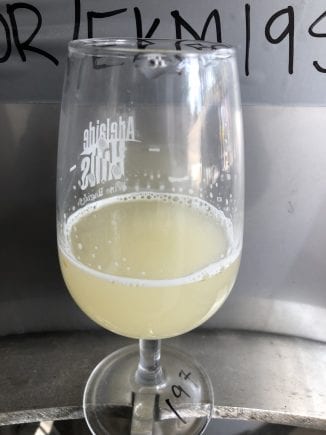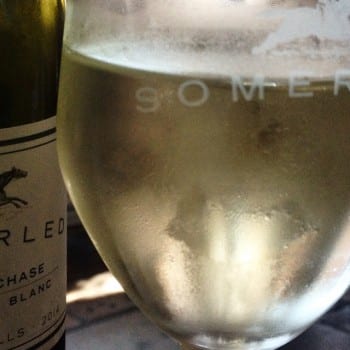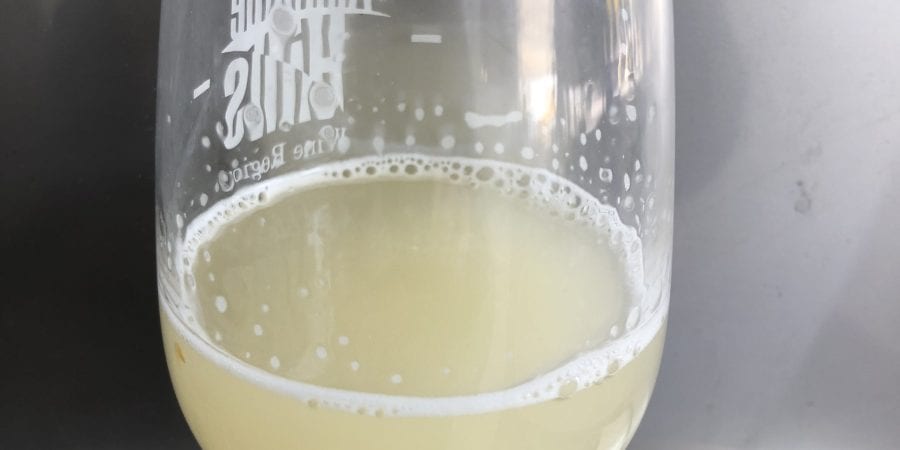Waiting, waiting, waiting… waiting for ferments to finish, waiting for malolactic bacteria to start doing its thing and STILL waiting to pick Tempranillo grapes. Lucky Rob is a very patient man.
Let’s see exactly what has(n’t) been happening in the winery…
Sauvignon Blanc:
Last week, we talked about ferments becoming “sugar dry” and how we need to do a glucose/fructose test to check exactly when all the sugar has been fermented. At last check, the level was down to 4 g/L, which means there is still a tiny bit of sugar left for the yeast to ferment. The ferment is considered “dry” when the level is less than 2 g/L.
So, not much happening there…
Pinot Noir for sparkling:
This one has pretty much finished fermenting all the sugar. There will be a final check on the glucose/fructose level this afternoon. If it is down to 2.0 g/L or less, the malolactic bacteria will be added. The wine is still very crisp, so the malic acid level is probably quite high at this point.
Again, not much to report…
Pinot Noir dry red:
The Pinot is sugar dry and the malolactic bacteria went in last week. There hasn’t been a check on the malic acid level this week but is on the cards for the next day or so.
Ummm, I’m starting to see a pattern here…
Tempranillo:
Ah-ha! Finally, something interesting to report!
Snips and Thermos’ at the ready… our team of Somerled pickers will be up nice and early tomorrow morning picking the grapes for our 2019 Tempranillo. I’ll be there to make sure I get lots of photos to share with you next week. Oh, and I guess I might pick a bunch or two while I’m there. It’s the least I can do.
2018 McLaren Vale Shiraz:
Oh, and this is exciting too. Rob has been busy tasting all of the barrels of 2018 Shiraz (yes, it’s a tough job) to decide which ones will make the cut. It won’t be too long before they find their way into the winery and Rob starts working magic.
THE NEXT STEP…
Back to the 2019 Sauvignon Blanc for a minute. At last taste, Rob commented that it is… “very tasty, except for the fact it’s full of yeast, and that always makes the wine hard to enjoy!”
Without getting too far ahead of myself, let’s see how Rob manages to turn his Sauvignon Blanc (and other wines) from something which looks like this…

To this…
Because, let’s face it, drinking a wine full of yeast doesn’t sound all that enjoyable.
As soon as the Sauvignon Blanc is sugar dry, Rob will put it through these few final stages in preparation for bottling…
Step 1: Fining
Firstly, a specific quantity of fining agent will be added to the tank. Fining agents react with all the unwanted compounds in the wine (like the leftover yeast cells causing that haziness you can see in the photo), forming clumps which sink to the bottom of the tank. This makes them easier to remove.
Commonly-used fining agents include…
- Gelatine
- Isinglass (derived from fish!)
- Egg albumen
- Casein
- Skim Milk
- Bentonite
- Carbon
- Polyvinylpolypyrrolidone (PVPP)
The quantity and type of agent used can cause subtle changes in the structure and taste of a wine. So it takes a very experienced and skillful winemaker (luckily we have one of those!) to choose the right one.
Check out this excellent article from the Australian Wine Research Institute on fining agents if you’d like to know more.
Step 2: Cold stabilisation
Have you ever drunk a wine and found what looks like shards of glass in the bottom of the bottle or, even worse, your glass? Well, don’t freak out… it’s not glass, but completely harmless and natural tartrate crystals which can form when a wine hasn’t been properly temperature stabilised. They are scientifically known as potassium bitartrate. If you’re a whizz in the kitchen you might also know them as cream of tartar!
Tartrates occur in wines when potassium and tartaric acid, both naturally occurring products of grapes, bind together to form a crystal. They are a normal bi-product of a wine as it ages, but cold temperatures (usually below around 4 degrees Celsius) can make them naturally combine with potassium to form a crystal.
The way to avoid this happening is to force this process in the winery before bottling. The tank is chilled down so far that ice forms on the outside and the tartrates form and sink to the bottom.
Step 3: Filtration
So, now that we have all these clumps (!) and crystals in the wine, what to do with them?
The final step in the process is to pass the wine through a filter on its way to the bottling line. This will remove all those unwanted particles and leave us with a beautifully clean wine, ready to be enjoyed by you!
And it won’t be too long before the first of our 2019 vintage wines will be ready to enjoy. Watch this space!
